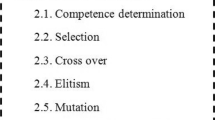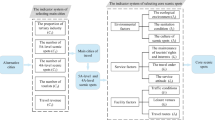Abstract
With the rapid development of tourism, it not only brings great economic benefits, but also causes some problems. Overcrowded visitors reduce tourists satisfaction and bring about negative impact on ecological environment. Designing a reasonable tourists initial shunt scheme can help the management of the scenic area to achieve the goal that balances the economic development and environment protection. In this paper, for the sake of alleviating congestion in scenic area, a tourists optimal shunt scheme is proposed. Instead of defining single optimal objective, the proposed scheme taking two objectives into account, which are minimizing the total load balance degree of the scenic spots and one spot’s load degree. In order to estimate optimal shunt ratios, a multi-objective optimization based on genetic algorithm is used to find the Pareto solution. Then a simulation model is built to investigate and verify the scheme. Finally, a comparison analysis validates the efficiency of the model in mitigating the load of the scenic spots in Jiuzhai Valley.





Similar content being viewed by others
References
Sharpley, R. (2014). Host perceptions of tourism: A review of the research. Tourism Management, 42(2), 37–49.
Ma, M., & Hassink, R. (2013). An evolutionary perspective on tourism area development. Annals of Tourism Research, 41(1), 89–109.
Budeanu, A., Miller, G., Moscardo, G., et al. (2016). Sustainable tourism, progress, challenges and opportunities: An introduction. Journal of Cleaner Production, 111(5), 285–294.
Huang, S., & Chen, G. (2016). Current state of tourism research in China. Tourism Management Perspectives, 20, 10–18.
Mathew, P., & Sreejesh, S. (2017). Impact of responsible tourism on destination sustainability and quality of life of community in tourism destinations. Journal of Hospitality & Tourism Management, 31, 83–89.
Butler, R. (1980). The concept of a tourist area cycle of evolution: Implications for management of resources. Canadian Geographer, 24(1), 5–12.
Smith, S. L. J. (1987). Regional analysis of tourism resources. Annals of Tourism Research, 14(2), 254–273.
Burger, C. J. S. C., Dohnal, M., Kathrada, M., et al. (2001). A practitioners guide to time-series methods for tourism demand forecasting-a case study of Durban, South Africa. Tourism Management, 22(4), 403–409.
Monz, C., D’Antonio, A., Lawson, S., et al. (2016). The ecological implications of visitor transportation in parks and protected areas: Examples from research in US National Parks. Journal of Transport Geography, 51, 27–35.
Murtagh, N., Gatersleben, B., & Uzzell, D. (2012). Multiple identities and travel mode choice for regular journeys. Transportation Research Part F Traffic Psychology & Behaviour, 15(5), 514–524.
Collum, K., & Daigle, J. (2015). Combining attitude theory and segmentation analysis to understand travel mode choice at a national park. Journal of Outdoor Recreation & Tourism, 9, 17–25.
Taff, D., Newman, P., Pettebone, D., et al. (2013). Dimensions of alternative transportation experience in Yosemite and Rocky Mountain National Parks. Journal of Transport Geography, 30(30), 37–46.
Mace, B., Marquit, J., & Bates, S. (2013). Visitor assessment of the mandatory alternative transportation system at Zion National Park. Environmental Management, 52(5), 1271.
Zhang, G., Gao, L., & Shi, Y. (2011). An effective genetic algorithm for the flexible job-shop scheduling problem. Expert Systems with Applications, 38(4), 3563–3573.
Deb, K. (2014). Multi-objective genetic algorithms: Problem difficulties and construction of test problems. Evolutionary Computation, 7(3), 205–230.
Konak, A., Coit, D., & Smith, A. (2006). Multi-objective optimization using genetic algorithms: A tutorial. Reliability Engineering & System Safety, 91(9), 992–1007.
Acknowledgements
This work was supported by the National Natural Science Foundation of China (Grant Nos. 71001075 and 61471090), and the Fundamental Research Funds for the Central Universities (Grant Nos. skqy201739 and skzx2017-sb35).
Author information
Authors and Affiliations
Corresponding author
Rights and permissions
About this article
Cite this article
Hu, T., Jin, M., Lei, X. et al. Tourists Initial Optimal Shunt Scheme Using Multi-objective Genetic Algorithm. Wireless Pers Commun 102, 3517–3527 (2018). https://doi.org/10.1007/s11277-018-5388-z
Published:
Issue Date:
DOI: https://doi.org/10.1007/s11277-018-5388-z




